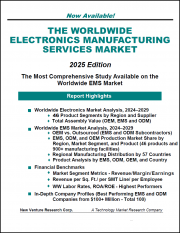
|
시장보고서
상품코드
1415575
세계의 통신 EMS(전자기기 수탁제조) 시장 평가 : 유형별, 조직 규모별, 용도별, 지역별, 기회, 예측(2017-2031년)Telecom Electronic Manufacturing Services Market Assessment, By Type, By Organization Size, By Application, By Region, Opportunities, and Forecast, 2017-2031F |
||||||
세계의 통신 EMS(전자기기 수탁제조) 시장 규모는 2023년 4,010억 달러로 평가되었고, 2031년 8,658억 5,000만 달러에 이를 전망이며, 2024년부터 2031년까지 CAGR 10.1%의 성장이 전망되고 있습니다.
전통적으로 세계의 통신 EMS(전자기기 수탁제조) 시장은 주로 PCB(PCB) 상의 컴포넌트 조립 및 OEM용 박스 빌드 제공 등 전자 제품 제조에 종사하는 기업으로 구성 되었습니다. 50년 이상 전에 시작된 이 시장은 당초 정부, 방위 및 연구 기관의 제조 설계를 수행하는 데 중점을 두었습니다. 이윽고 OEM의 생산능력을 뛰어넘는 수요 증가에 대응하기 위해 시장이 확대되었습니다.
오늘날 OEM과 ODM 제조업체는 통신용 EMS 기업에 큰 가치가 있다는 것을 인식하고 단순한 제조 서비스뿐만 아니라 EMS 기업과의 관계를 넓히고 있습니다. 여기에는 제품 설계 및 개발, 테스트, 애프터 서비스(수리 및 재제조 포함), 마케팅, 종합적인 제품 수명 주기 관리 등이 포함됩니다. 기존에는 3C(컴퓨터, 통신, 소비자 일렉트로닉스) 제품이 EMS 시장의 수익을 독점하고 있었지만, 데이터, 자동화, AI에 대한 의존성 증가를 특징으로 하는 디지털 시대의 도래로 통신 산업 전체에서 전자 장비의 임베디드 수요가 크게 증가하고 있습니다.
세계적으로 중소기업(SME)과 영세 중소기업(MSME)은 생산 라인에 엄청난 설비 투자를 피하기 위해 제3자 제조 서비스를 채택하는 경향이 커지고 있습니다. 그들은 서비스 제공 업체의 설계 전문성 및 제조 능력을 활용합니다. IFC에 따르면 개발도상국의 정식 영세 중소기업의 약 40%를 차지하는 약 6,500만 회사가 재무상의 미충족 요구에 직면하고 있습니다. 세계 기업의 상당 부분이 특히 개발도상국에서는 중소기업으로 분류된다는 점을 감안하면, 제조 서비스 제공업체에 대한 의존은 EMS(전자기기 수탁제조) 시장의 미래 성장 궤도를 형성하는 데 매우 중요한 역할을 할 것으로 예측됩니다.
견고한 5G 인프라 구축이 상당한 시장 성장에 기여
견고한 5G 인프라 확립은 첨단 장비 수요를 촉진함으로써 통신 EMS(전자기기 수탁제조)에 큰 영향을 미칩니다. 5G 네트워크는 특수하고 고성능 부품을 필요로 하기 때문에 EMS 제공업체는 이러한 첨단 기술을 이용한 장비를 제조하는 데 매우 중요합니다. 5G 기술의 배포에는 데이터 스토리지, 안테나, 기지국, 스몰셀 등 다양한 컴포넌트의 제조가 필요하며 EMS 부문의 성장을 가속하고 있습니다. 5G 네트워크의 복잡성과 고도화로 인해 전문 EMS 공급업체에 대한 제조 위탁의 중요성이 높아지고 있습니다. 통신 사업자는 진화하는 통신 환경 수요에 대응하기 위해 효율적이고 신뢰성 높은 파트너를 세계적으로 요구하고 있기 때문에 5G 관련 기기 제조에 특화된 솔루션을 제공하는 기업은 이익을 얻을 수 있습니다. 이러한 견고한 5G 인프라 구축과 전문적인 전자기기 제조 서비스 수요와의 역동적인 관계는 이 두 부서가 서로 얽혀 성장하고 있음을 보여줍니다.
GSMA의 추계에 의하면, 2021년의 5G 보급은 중화권이 리드해, 모바일 유저의 29%가 이 신규격을 이용하고 있습니다. 북미가 13%, 유럽이 4%로 이에 이릅니다. 예측에 따르면 북미는 2025년까지 중국을 뛰어넘어 5G 보급률이 63%에 달하지만, 다른 지역은 4G 의존도를 유지할 것으로 예측되고 있습니다. 주목할 만한 것은 Saudi Telecom으로 대표되는 사우디아라비아이며, 가장 광범위한 5G 범위를 자랑하고, 2030년까지 새롭게 4,500만대의 5G 대응 IoT 디바이스의 접속을 전망하고 있습니다. 기타 스페인, 이탈리아, 호주, 캐나다, 영국, 한국, 핀란드 등이 5G에 적응하는 최전선에 있습니다.
본 보고서에서는 세계의 통신 EMS(전자기기 수탁제조) 시장에 대해 조사 분석하여 시장 규모 및 예측, 시장 역학, 주요 기업 상황 및 전망 등의 정보를 제공합니다.
목차
제1장 조사 방법
제2장 프로젝트의 범위 및 정의
제3장 통신 EMS(전자기기 수탁제조) 시장에 대한 COVID-19의 영향
제4장 주요 요약
제5장 통신 EMS(전자기기 수탁제조) 시장 전망(2017-2031년)
- 시장 규모 및 예측
- 금액
- 유형별
- 엔지니어링 및 전자 설계
- 수탁 제조
- 테스트 및 검증
- 조달 및 공급망 관리
- 기타
- 조직 규모별
- 대규모
- 중소기업
- 용도별
- 컴퓨팅 디바이스 및 설비
- 데이터센터 및 스토리지
- 송수신기 및 송신기
- 기타
- 지역별
- 북미
- 유럽
- 남미
- 아시아태평양
- 중동 및 아프리카
- 시장 점유율 : 기업별(2023년)
제6장 통신 EMS(전자기기 수탁제조) 시장 전망 : 지역별(2017-2031년)
- 북미
- 시장 규모 및 예측
- 유형별
- 조직 규모별
- 용도별
- 미국
- 유형별
- 조직 규모별
- 용도별
- 캐나다
- 멕시코
- 유럽
- 독일
- 프랑스
- 이탈리아
- 영국
- 러시아
- 네덜란드
- 스페인
- 터키
- 폴란드
- 남미
- 브라질
- 아르헨티나
- 아시아태평양
- 인도
- 중국
- 일본
- 호주
- 베트남
- 한국
- 인도네시아
- 필리핀
- 중동 및 아프리카
- 사우디아라비아
- 아랍에미리트(UAE)
- 남아프리카
제7장 시장 매핑(2023년)
- 유형별
- 조직 규모별
- 용도별
- 지역별
제8장 거시적 환경 및 산업 구조
- PESTEL 분석
- Porter's Five Forces 분석
제9장 시장 역학
- 성장 촉진요인
- 성장 억제요인(과제 및 성장 억제요인)
제10장 주요 기업 정세
- 마켓 리더 상위 5개사의 경쟁 매트릭스
- 마켓 리더 상위 5개사 시장 수익 분석(2023년)
- 인수합병(M&A) 및 합작사업(해당하는 경우)
- SWOT 분석(시장 참가 기업 5사)
- 특허 분석(해당하는 경우)
제11장 가격 분석(해당하는 경우)
제12장 사례 연구(해당하는 경우)
제13장 주요 기업의 전망
- Benchmark Electronics Inc
- Flex Ltd.
- Sanmina Corporation
- Jabil Inc.
- Celestica Inc.
- Wistron Corporation
- 킨포그룹
- BYD Company Limited
- Pegatron Corporation
- Plexus Corp
제14장 전략적 권장사항
제15장 기업소개 및 면책사항
AJY 24.02.07Global telecom electronic manufacturing services (EMS) market size was valued at USD 401 billion in 2023, the market is forecasted to reach a value of USD 865.85 billion by 2031, displaying a CAGR of 10.1% from 2024 to 2031. Telecom electronic manufacturing service involves outsourcing the production of electronic components and devices for the telecommunications industry to a specialized manufacturing service provider. This includes the design, assembly, testing, and packaging of products like routers, switches, and communication equipment.
Traditionally, the global market for telecom electronics manufacturing services consisted of companies engaged in producing electronic products, primarily assembling components on printed circuit boards (PCBs) and providing box builds for original equipment manufacturers (OEMs). Originating over five decades ago, the market initially focused on executing manufacturing designs from government, defense, and research institutions. Over time, it expanded to accommodate escalating demands that surpassed volume capacities within OEMs.
Today, OEMs and original design manufacturers (ODMs) recognize greater value in telecom EMS companies, leading to expanded involvement beyond mere manufacturing services. This includes product design and development, testing, aftersales services (including repair, remanufacturing), marketing, and comprehensive product lifecycle management. While conventionally, 3C (Computer, Communication, and Consumer Electronics) products dominated EMS market revenue, the advent of the digital age, characterized by a growing reliance on data, automation, and artificial intelligence, has significantly increased the demand for embedding electronics across telecom industry.
Globally, small and medium enterprises (SMEs) and micro, small, and medium enterprises (MSMEs) increasingly embrace third-party manufacturing services to circumvent substantial capital investments in production lines. They leverage the design expertise and manufacturing capabilities of service providers. According to the International Finance Corporation (IFC), approximately 65 million firms, constituting about 40% of formal micro, small, and medium enterprises in developing nations, face unmet financial needs. Given that a significant portion of businesses worldwide falls under the category of small and medium enterprises, especially in developing countries, their reliance on manufacturing service providers is expected to play a pivotal role in shaping the future growth trajectory of the electronic manufacturing services (EMS) market.
Robust 5G Infrastructure Establishment Contributing Significant Market Growth
Establishing a robust 5G infrastructure significantly influences telecom electronic manufacturing services (EMS) by driving demand for advanced equipment. As 5G networks require specialized and high-performance components, EMS providers are pivotal in manufacturing these technologically advanced devices. The deployment of 5G technology necessitates the production of diverse components, such as data storage, antennas, base stations, and small cells, fostering growth in the EMS sector. The increased complexity and sophistication of 5G networks amplifies the importance of outsourcing manufacturing to specialized EMS providers. Companies offering tailored solutions for 5G-related equipment manufacturing stand to benefit, as telecom operators globally seek efficient and reliable partners to meet the demands of the evolving telecommunications landscape. This dynamic relationship between the establishment of robust 5G infrastructure and the demand for specialized electronic manufacturing services underscores the intertwined growth of these two sectors.
GSMA estimates indicate that Greater China led in 5G adoption in 2021, with 29% of mobile users utilizing this new standard. North America and Europe followed with 13% and 4% respectively. Predictions suggest North America will surpass China by 2025, achieving 63% 5G adoption, while other regions are expected to maintain their reliance on 4G. Notably, Saudi Arabia, represented by Saudi Telecom, boasts the most extensive 5G coverage and anticipates connecting 45 million new 5G-supported IoT devices by 2030. Other nations at the forefront of 5G adaptation include Spain, Italy, Australia, Canada, the UK, South Korea, and Finland.
Demand for Advanced Semiconductors Facilitating Telecom EMS Market
The escalating demand for advanced semiconductors significantly impacts the telecom EMS market. As telecommunications technologies evolve, there's a growing need for high-performance chips and integrated circuits that power modern communication devices. Advanced semiconductors are pivotal in developing IoT devices and other cutting-edge telecommunications equipment. EMS providers are experiencing increased pressure to incorporate the latest semiconductor technologies into their manufacturing processes to meet the demands of telecom companies. The surge in data-intensive applications and the widespread adoption of 5G requires semiconductors with enhanced processing capabilities and increased energy efficiency. This trend is reshaping the landscape of electronic manufacturing services, pushing providers to invest in state-of-the-art semiconductor manufacturing capabilities. As the telecom industry continues to rely on advanced semiconductor components for innovation, EMS providers that can efficiently integrate these technologies into their production processes are poised to capitalize on the expanding market demand.
The CHIPS Act allocates USD 280 billion in expenditures over the next decade, primarily focusing on scientific research and development (R&D) and commercialization, accounting for USD 200 billion. Within this, USD 52.7 billion is earmarked for semiconductor manufacturing, R&D, and workforce development, complemented by an additional USD 24 billion in tax credits to incentivize chip production. An allocation of USD 3 billion is designated for programs targeting leading-edge technology and enhancing wireless supply chains. This comprehensive funding strategy aims to bolster the semiconductor industry, fostering innovation, advancing manufacturing capabilities, and reinforcing workforce development while promoting critical technologies and securing the wireless supply chain.
Asia-Pacific Dominates the Telecom EMS Market
Asia-Pacific predominantly dominates the telecom EMS market. This is attributed to several factors contributing to the region's leadership in electronic manufacturing. Countries such as China, Taiwan, South Korea, and Japan have emerged as key players in the global EMS landscape. Asia Pacific's dominance is fueled by its well-established electronics manufacturing infrastructure, cost-effective labor, and a robust ecosystem of suppliers and components.
Moreover, the region has been at the forefront of technological advancements and innovation, making it a preferred destination for telecom companies outsourcing their manufacturing needs. The presence of major original equipment manufacturers (OEMs) and a skilled workforce further solidifies Asia Pacific's position in the Telecom EMS market. The dynamic growth of the telecommunications sector in the Asia Pacific region, coupled with its manufacturing prowess, positions it as a powerhouse in meeting the demands of electronic manufacturing services for the telecom industry.
China, recognized as the world's largest exporter of electronic products, particularly portable computers and mobile phones, plays a pivotal role in the global electronics market. As of June 2020, the electronics manufacturing sector in China boasted 43,981 industrial enterprises, employing a substantial workforce of 13,289,000 (CALSS, 2020). Among these enterprises, 57% were engaged in the manufacturing of electrical machinery and equipment, providing jobs for 5,150,000 workers. The remaining 43% encompassed communication equipment manufacturers, computers, and other electronic devices, contributing to a workforce of 8,139,000. This data underscores China's significant presence and impact within the expansive realm of the electronics manufacturing sector.
Government Initiatives
The PLI scheme of various countries promoted the domestic manufacturing and export of electronic products, providing companies with incentives based on incremental sales compared to the base year. For instance, India's significant electronic manufacturing sector, the Large-Scale Electronic Manufacturing (LSEM) sector, has been allocated a substantial sum of approximately USD 5 billion under this initiative. This allocation has spurred increased investments in the sector, attracting global electronics giants like Samsung and Apple, which have established manufacturing facilities in India.
Key government initiatives to enhance domestic production in electronics and IT hardware include the Scheme for Promotion of Manufacturing of Electronic Components and Semiconductors (SPECS), offering financial incentives for their production. The Modified Electronics Manufacturing Clusters (EMC 2.0) initiative aims to create world-class infrastructure for electronics manufacturing. Additionally, the government has liberalized foreign direct investment, allowing up to 100% FDI for electronics manufacturing.
Impact of COVID-19
The emergence of the coronavirus significantly impacted the demand for electronic manufacturing services, mainly due to the pandemic's severe repercussions on the global electronics supply chain. Key players in the market experienced substantial revenue declines due to the COVID-19 pandemic.
Moreover, the pandemic had detrimental effects on the electronics manufacturing industry in 2020, attributed to disrupted supply chains for components, restricted technology movement, worksite coordination challenges, cybersecurity concerns, and under-absorption of fixed costs. Companies encountered shortages of specific electronic components like capacitors, connectors, memory (DRAM and Flash), and LCD panels. Consequently, productivity levels were reduced across facilities during the initial two quarters of 2020, with Jabil Inc. reporting operating capacities at approximately 65-70%.
While the impact on the electronics manufacturing industry was expected to be more extensive if the virus affected major industrial countries beyond Germany, India, China, and the U.S., long-term prospects indicated a robust recovery. Anticipated increases in product development and demand across healthcare, automotive, computer, and communication sectors were projected. Remote monitoring electronic devices played a crucial role in sustaining business operations during lockdowns, exemplified by Benchmark Electronics, Inc.'s partnership with DnaNudge in September 2020 to produce DnaNudge's re-engineered lab-free RT-PCR COVID-19 testing system at scale.
Key Players Landscape and Outlook
The telecom electronic manufacturing services market is expanding due to the increasing emphasis placed by companies worldwide on establishing 5G infrastructure. Furthermore, the market expansion is exponentially facilitated by investments made by companies to enhance research and development resources, engage in collaboration projects, bolster marketing efforts, and expand distribution networks. These factors collectively contribute to the rapid expansion of the market.
In October 2022, Rockwell Automation Inc. disclosed the finalization of a definitive agreement to acquire CUBIC, a specialist in modular systems for constructing electrical panels. This partnership anticipates delivering advantages such as expedited time to market, facilitating broader plant-wide applications for intelligent motor control, and generating smart data to enhance sustainability and productivity across a diverse customer base.
Table of Contents
1. Research Methodology
2. Project Scope & Definitions
3. Impact of COVID-19 on Telecom Electronic Manufacturing Services Market
4. Executive Summary
5. Telecom Electronic Manufacturing Services Market Outlook, 2017-2031F
- 5.1. Market Size & Forecast
- 5.1.1. By Value
- 5.2. By Type
- 5.2.1. Engineering and Electronics Design
- 5.2.2. Contract Manufacturing
- 5.2.3. Test & Validation
- 5.2.4. Sourcing & Supply Chain Management
- 5.2.5. Others
- 5.3. By Organization Size
- 5.3.1. Large Scale
- 5.3.2. SMEs
- 5.4. By Application
- 5.4.1. Computing Devices & Equipment
- 5.4.2. Data Centers & Storages
- 5.4.3. Transceivers and Transmitters
- 5.4.4. Others
- 5.5. By Region
- 5.5.1. North America
- 5.5.2. Europe
- 5.5.3. South America
- 5.5.4. Asia-Pacific
- 5.5.5. Middle East and Africa
- 5.6. By Company Market Share (%), 2023
6. Telecom Electronic Manufacturing Services Market Outlook, By Region, 2017-2031F
- 6.1. North America*
- 6.1.1. Market Size & Forecast
- 6.1.1.1. By Value
- 6.1.1. Market Size & Forecast
- 6.2. By Type
- 6.2.1. Engineering and Electronics Design
- 6.2.2. Contract Manufacturing
- 6.2.3. Test & Validation
- 6.2.4. Sourcing & Supply Chain Management
- 6.2.5. Others
- 6.3. By Organization Size
- 6.3.1. Large Scale
- 6.3.2. SMEs
- 6.4. By Application
- 6.4.1. Computing Devices & Equipment
- 6.4.2. Data Centers & Storages
- 6.4.3. Transceivers and Transmitters
- 6.4.4. Others
- 6.5. United States*
- 6.5.1.1. Market Size & Forecast
- 6.5.1.1.1. By Value
- 6.5.2. By Type
- 6.5.2.1. Engineering and Electronics Design
- 6.5.2.2. Contract Manufacturing
- 6.5.2.3. Test & Validation
- 6.5.2.4. Sourcing & Supply Chain Management
- 6.5.2.5. Others
- 6.5.3. By Organization Size
- 6.5.3.1. Large Scale
- 6.5.3.2. SMEs
- 6.5.4. By Application
- 6.5.4.1. Computing Devices & Equipment
- 6.5.4.2. Data Centers & Storages
- 6.5.4.3. Transceivers and Transmitters
- 6.5.4.4. Others
- 6.5.5. Canada
- 6.5.6. Mexico
All segments will be provided for all regions and countries covered:
- 6.6. Europe
- 6.6.1. Germany
- 6.6.2. France
- 6.6.3. Italy
- 6.6.4. United Kingdom
- 6.6.5. Russia
- 6.6.6. Netherlands
- 6.6.7. Spain
- 6.6.8. Turkey
- 6.6.9. Poland
- 6.7. South America
- 6.7.1. Brazil
- 6.7.2. Argentina
- 6.8. Asia-Pacific
- 6.8.1. India
- 6.8.2. China
- 6.8.3. Japan
- 6.8.4. Australia
- 6.8.5. Vietnam
- 6.8.6. South Korea
- 6.8.7. Indonesia
- 6.8.8. Philippines
- 6.9. Middle East & Africa
- 6.9.1. Saudi Arabia
- 6.9.2. UAE
- 6.9.3. South Africa
7. Market Mapping, 2023
- 7.1. By Type
- 7.2. By Organization Size
- 7.3. By Application
- 7.4. By Region
8. Macro Environment and Industry Structure
- 8.1. PESTEL Analysis
- 8.2. Porter's Five Forces Analysis
9. Market Dynamics
- 9.1. Growth Drivers
- 9.2. Growth Inhibitors (Challenges, Restraints)
10. Key Players Landscape
- 10.1. Competition Matrix of Top Five Market Leaders
- 10.2. Market Revenue Analysis of Top Five Market Leaders (in %, 2023)
- 10.3. Mergers and Acquisitions/Joint Ventures (If Applicable)
- 10.4. SWOT Analysis (For Five Market Players)
- 10.5. Patent Analysis (If Applicable)
11. Pricing Analysis (If Applicable)
12. Case Studies (If applicable)
13. Key Players Outlook
- 13.1. Benchmark Electronics Inc
- 13.1.1. Company Details
- 13.1.2. Key Management Personnel
- 13.1.3. Products & Services
- 13.1.4. Financials (As reported)
- 13.1.5. Key Market Focus & Geographical Presence
- 13.1.6. Recent Developments
- 13.2. Flex Ltd.
- 13.3. Sanmina Corporation
- 13.4. Jabil Inc.
- 13.5. Celestica Inc.
- 13.6. Wistron Corporation
- 13.7. Kinpo Group
- 13.8. BYD Company Limited
- 13.9. Pegatron Corporation
- 13.10. Plexus Corp
Companies mentioned above DO NOT hold any order as per market share and can be changed as per information available during research work.



















